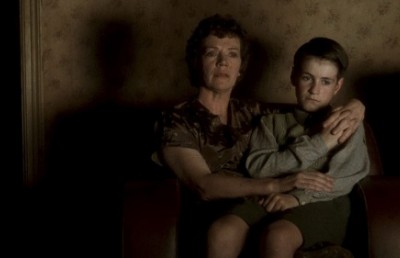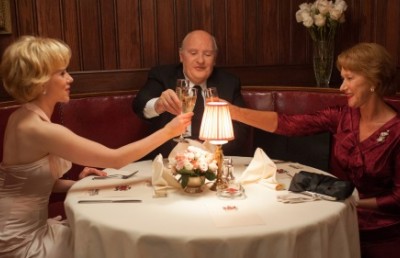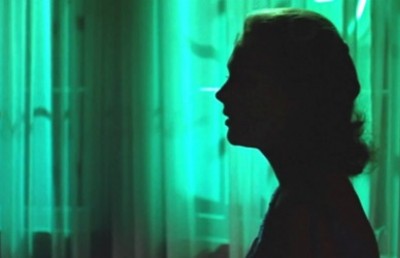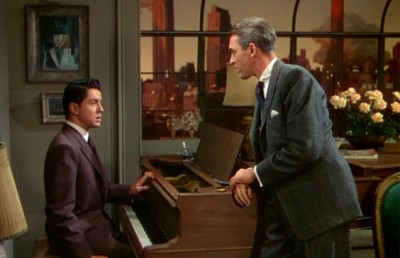Eccentric Sensibilities: A Quiet Passion, a film on Emily Dickinson by Terence Davies
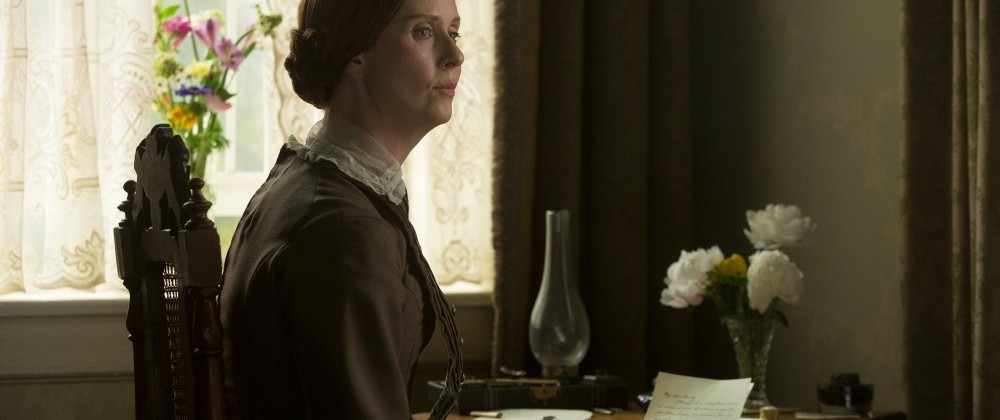
Everyone—every woman, every man, even every child—must attempt to find the things that mean something to him or her; and yet we are encouraged—bullied, charmed, distracted—into taking on people, places, and things that serve others more than they serve us. The old idols are paraded before us, we who are looking for new spirits; and we know that everything—our wants, and what is offered by others—must be questioned, tested, before they are accepted as necessary or inevitable. Do you wish to come to god and be saved?—that is the question that a student, a young woman, Emily Dickinson, is asked. Emily feels indefinite, unawakened, not moved to make a religious commitment. The Terence Davies film A Quiet Passion (2016), on the life and work of the great American poet Emily Dickinson, opens in a women’s school, Mount Holyoke, during Emily Dickinson’s second semester there. Emily is told by a teacher (headmistress Mary Lyon?) that her lack of commitment to the established deity makes her alone in her rebellion. The young Emily is played by Emma Bell and the older Emily is played by Cynthia Nixon, whose voice we hear reciting poetry. Emily Dickinson’s family—her sister, brother, and father—come to the school in answer to the distress they read in her letters home. What was at the root of Emily’s despair? In a two-verse poem called “The Mystery of Pain,” Dickinson observed of pain, “It has no future but itself, Its infinite realms contain / Its past, enlightened to perceive / New periods of pain.” The poem appears in a plain collection of her work entitled Poems, edited by Johanna Brownell, published by Castle Books of Book Sales, Inc., year 2000, in Edison, New Jersey; page 11. What was Emily Dickinson’s illness, her pain, which her rescuing father and siblings arrive to tend? An acute case of evangelism, she says. Emily, like the others in her family, has an independence of mind. She spent no more than a year at Mount Holyoke. Emily Dickinson would cultivate her own mind, and her clarity of thought, her considerations of life and death, ever so distinct, would reach the willing reader, eventually.
Isolated and passionate, spiritual and worldly, Emily Dickinson (1830 – 1886) was the descendant of people who left England and its church for New England Calvinism, the granddaughter of landowner and educator Samuel Fowler Dickinson and his wife Lucretia Gunn Dickinson, and the daughter of lawyer and legislator Edward Dickinson and Emily Norcross Dickinson; the younger sister of Austin, the older sister of Lavinia. The poet, Emily, was an idealist and a sceptic, a reader and a writer, a baker and a cook, a woman both mythic and mundane. Emily Dickinson, educated in both home and school, described childhood as both a time of freedom and a prison, suggesting an ability to see different aspects of the same experience. She had favored friends and relished reading and respected those who embodied knowledge. A student of the children’s school Amherst Academy, with friends such as Abiah Root, Abby Wood, and Emily Fowler, and later the women’s college Mount Holyoke, Emily was the recipient of a good education (algebra and geometry, botany, chemistry, history, and composition and rhetoric—writing), an indication that knowing what others have thought allows one to seek and know what is original.
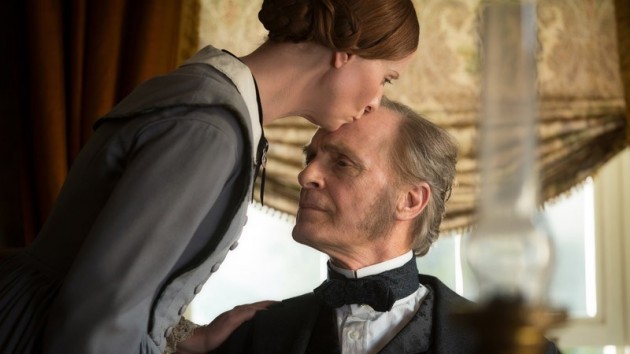
For Dickinson, who knew the eloquence and wisdom of the King James Bible, “no books were more valued by her than Shakespeare’s, particularly his tragedies. She revered nineteenth-century English writers, particularly Elizabeth Barrett Browning, Charlotte and Emily Bronte, and George Eliot. Ralph Waldo Emerson, Henry Thoreau and Nathaniel Hawthorne were presences to her,” writes scholar Sharon Leiter in Critical Companion to Emily Dickinson: A Literary Reface to Her Life and Work (Facts on File, 2007; page 9). Dickinson is known to have read Thomas Carlyle, Charles Darwin, and Matthew Arnold as well. (The life and work of Emily Dickinson have been surveyed in biographies, critical studies, fiction, and poetry, such as Richard Sewall’s 1979 biography and the 2016 University of Pennsylvania Press book Our Emily Dickinsons by Vivian Pollak, who considers Dickinson as seen, as interpreted, by other women poets.) Through literature, Emily Dickinson’s companions and teachers were some of the most formidable thinkers and writers of the age: in an eight-line poem, “A Book,” with each line beginning with a capital letter, Dickinson said of one reader, “He danced along the dingy days, / And this bequest of wings / Was but a book. What liberty / A loosened spirit brings!” (Poems, Castle Books, 2000; page 12). Emily Dickinson as poet celebrated nature, commented ironically on society, and explored the great expanse of the human world within us. Her imagination is fierce, intellectual grasp sure, feeling strong. There is nothing insignificant about her vision or language, as Dickinson commands austerity and wit, aphorism and allusion, comparison and contrast, conviction and definition, ellipses and evasion, fact and metaphor. Her work has an elemental weight, an irreducible force.
“I NEVER saw a moor, / I never saw the sea; / Yet I know how the heather looks, / And what a wave must be,” Emily Dickinson wrote in a series of poems—under the rubric “Time and Eternity”—affirming imagination and faith, including faith in the divine (Poems; page 49). Her work could sound musical, and it could defy melody. Emily Dickinson, a startling poet, a writer of deep confirmations, whose lines of a mere six to eight syllables, of three to four beats per line, full of dashes and capital letters, is a writer admired by essayist James Baldwin, visual artist Joseph Cornell, and poets such as Elizabeth Bishop, Marianne Moore, and Adrienne Rich, and playwright William Luce (The Belle of Amherst, 1976), as well as, among many others, the filmmaker Terence Davies. Emily Dickinson, whose work, drawing on her original manuscripts, has been presented in canonical versions by Thomas Johnson in 1955 and R.W. Franklin in 1998, is shown as the central figure in a family of intelligent eccentrics in the film A Quiet Passion, by director Terence Davies, whose oeuvre contains Distant Voices, Still Lives (1988), and The Neon Bible (1996), House of Mirth (2000), The Deep Blue Sea, and Sunset Song (2015). A Quiet Passion, available in Britain in 2016 and in America in 2017, is formal and intimate, by turns a tableau, recitation, dialogue, interrogation, play, photo album, and motion picture; full of intellect and given to bursts of emotion, it creates a vision of people who are at once simple and inexplicably strange. Emily Dickinson’s family is her tribe but they are not always in agreement. A classical music recital is attended by Emily and her family, but her father disapproves of a performing woman, and Emily’s aunt disapproves of English-language singing. One intuits a fear of clarity, of female force, of vulgarity. What is expected of Emily, an intelligent woman, one drawn to poetry? The young Emily seems warm, passionate, as well as confident and clever. Her father approves of her desire to write at night when the house is quiet. An early poem is published; but Emily will have few poems published during her breathing life, and, later, as an older woman, isolated, a recluse, she seems sharp, a bit starved.
Emily’s Aunt Elizabeth (Annette Badland)—her father’s sister?—thinks that Emily Dickinson and her siblings, inclined toward free thinking and the abolition of slavery, are too sophisticated. It is an odd observation coming from a woman who seems knowing: it is as if people are expected to be intelligent but not to think interesting things. (Apparently, Emily had a warmer relation with an aunt who was her mother’s sister, Lavinia Norcross, someone who took care of Emily when she was a baby and whom Emily sometimes sought in times of trouble.) The family is witty. Emily says that poems are her solace (she would write of nature, of solitude, of fellowship, of trouble, of death); and her aunt counsels against vanity and vice. “The heart asks pleasure first,” recites actress Cynthia Nixon, the older Emily.
A Quiet Passion is a somber, thoughtful film with explosions of feeling and humor, like Emily Dickinson’s poetry, from which it draws insight. Its imagery brings to mind thought of the browns and yellows of Rembrandt portraiture, too. The outside walls of the house are yellow with green shutters. The interiors are darkly lit: the music auditorium, where the family hears the music recital, has candles, and the family home has a fireplace and windows as well as candles. Emily plays a hymn on piano for her reclusive mother (Joanna Bacon), a strange woman, melancholy but observant and honest: as a girl Emily’s mother had been studious, interested in science, and there has been speculation that the personal sacrifice and social entertaining expected of a prominent wife were not to her liking. (In one of Emily Dickinson’s letters to her admiring friend Thomas Wentworth Higginson, a literary man of progressive political views impressed by her work though he did not always understand her style—Higginson who after her death would help introduce the poet’s work to the world—Emily described herself as motherless, suggesting what her mother’s withdrawal meant to her. Her mother may have been suffering from a long grief, after the death of several relatives, as Sharon Leiter notes in Emily Dickinson: A Literary Reference to Her Life and Work, published by Facts on File in 2007.) Intelligence and sensitivity—refinement—as both accomplishment and limitation? Is that what becomes of eight generations of a New England family? Were these people too intelligent for the world in which they lived; or were they just intelligent enough to create a civilization from which we still draw? Were the children too bright, not enough a part of the neighboring society? “Captivity is consciousness, / So’s liberty,” wrote Dickinson, contemplating body and spirit, threat and defiance, in “Emancipation” (Poems; page 58).
Emily and her sister Lavinia, called Vinnie (Jennifer Ehle), Vinnie who had attended the women’s seminary Ipswich, make a new friend, a lovely, eccentric, spirted woman, a teacher, Miss Vryling Buffam (Catherine Bailey), an actual friend of Vinnie who is used by writer-director Davies to suggest the women friends of Dickinson. Davies, himself inspired by classic literature and the films of Olivia de Havilland and Joan Crawford, gives us a Miss Vryling Buffam of great ease, although hers may be a temporary freedom (will she marry?). The friendship of women was its own province, where love and truth and irreverence could be found; and Miss Buffam is someone really fun, and she tells Emily and Vinnie, as they leave Miss Buffam to go to church, “Don’t enjoy your praying too much—it might be habit-forming.” Religion was communal and personal, and Emily does refuse religious rigidity in a very religious culture. “I will not be forced to piety,” Emily says; further, “My soul is my own.” Her father Edward (Keith Carradine) reprimands Emily for her behavior—critical, honest, proud—during a minister’s visit: she refuses to kneel and pray. Emily has rebellious moments—when her father complains of a dirty plate, she breaks it, saying “It is dirty no more.” That is funny and a bit terrifying. She refuses church attendance, saying that her god knows her soul—her father is saddened by the refusal. (“FAITH is a fine invention / For gentlemen who see; / But microscopes are prudent / In an emergency!” Dickinson wrote in an untitled verse, numbered 30, under the rubric “Life” (Poems; page 75). Emily Dickinson loved nature, and respected science, but had reservations about science’s inclination to reduce living things to categories; and the freedom of her imagination, mind, and spirit gave her work its emphatic and experimental force. Focus and ferocity may be expected from a scientist, doctor, or lawyer, but not from a poet; and yet discipline, commitment, and honesty, as well as creative ambition, may demand—or produce—exactly that passion in any profession. (Scholar Helen Vendler has noted how Dickinson’s work can echo hymns and liturgy with reverence or mockery, and discussed the poem “In the name of the Bee,” for which Dickinson replaced the holy trinity with a bee, a butterfly, and a breeze.)
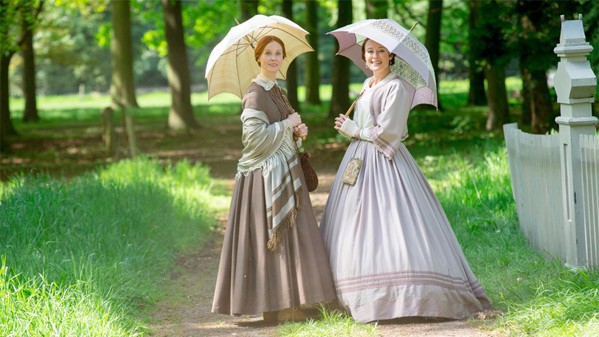
Meanwhile Emily’s brother Austin is away and courting; and Austin sends his family photos of himself and his fiancée, Susan Gilbert, a teacher who had been a tavern owner’s daughter reared by an aunt and older sister in different locations, and educated, like Emily, at Amherst Academy. He, Austin (Duncan Duff), will come home, welcomed by his mother, father, and sisters, to practice law with his father, bringing Susan (Jodhi May) as his new wife. (Emily had a correspondence with Susan Gilbert before the engagement and marriage, one notable for its intensity.) Will Emily marry? She is creating or maintaining other connections, even as the women she considers colleagues or companions consider the more conventional course; and it might have been a great comedy or tragedy to see these women, one by one, give in to marriage. Emily and Vinnie’s new teacher friend, Miss Buffam (Catherine Bailey), says that she has not found romance at any of the commencement balls she has attended. Miss Buffam is flirtatious but not yet willing to give up her own perspective for that of a suitor. Preparing to wish Miss Buffam goodbye, Emily (Nixon) advises, “Don’t do anything against god,” and the irreverent teacher says, “I’ll stop yodeling then.” Subsequently, they discuss the fates of women; and Emily admits that she cannot imagine herself beyond her family, something that suggests the depth and intimacy of family but a limitation too. Different people inspire us to explore different aspects of our personalities; and there are things that family members cannot—and must not—be for each other. The threat of incest and madness often seems to loom over families that are too close.
What, or whom, nourishes us? Our hungers and needs may be ignored, neglected, but they live on, although we may not recognize the power of them. Emily (Nixon) is getting older; and she has swollen hands and feet, and an attack of pain, which sends her to the floor and causes rudeness with the house staff when they all rush to accomplish a single, small task, picking up what she has dropped (they are employees, not servants, her father says); and Emily apologizes to them. Emily has rages, the kind that build over time: analysis and complaint and disapproval grow in solitary contemplation, in frustration and loneliness, until they can be incited by small, irrelevant incidents. (Emily did not have the husband and children that enrich, limit, and order many other women’s lives; and the lack of ordinary connections and constraints may be why her work ranges so widely.) “I’m nobody. Are you nobody too?” Emily asks of Austin and Susan’s little baby. The rages and responsibilities of the world surrounds the family; and when Fort Sumter is fired on, initiating a civil war, Austin wants to go and fight but his father Edward (Carradine) does not want Austin (Duff) to go, and they argue about the public and private responsibilities of a gentleman. (The film allows us scenes of different bloody battlegrounds with a tally of the dead.) Austin looks doubtful. Austin seems strange, as does the mother, as does Emily: Austin is no longer the handsome bright young man (as portrayed when younger by actor Benjamin Wainwright), but a bit shrunken. What has he been hungry for?
Emily Dickinson and her brother, like many of us, may have wanted enlightenment, good work, friendship and love, and comfort and security; but we tend to see life by our own lights and eyes, by our own principles and priorities—so what is good work or love for one may not be that for another person. Were family and friends enough for Emily? Had she given up the prospect of marriage to guard her independent spirit and work? Did her gain equal her sacrifices as a woman, as that gain may have surpassed her sacrifices as a poet? Emily Dickinson is discussed as a celibate woman in literature and gender studies professor Benjamin Kahan’s Celibacies: American Modernism and Sexual Life, published by Duke University Press in 2013: “Despite its allergy to celibacy, modernist scholarship has always charted figures who were sexually recalcitrant, indifferent, alienated, unattached, lonely, and lifelong or periodic celibates—a partial list of whom might include Gustave Flaubert, Emily Dickinson, Baron Corvo, George Santayana, Marcel Proust, Alfred Jarry, Rainer Maria Rilke, E.M. Forster, Franz Kafka, Edna Ferber, Edith Sitwell, T. E. Lawrence, Henry Darger, Josef Sudek, J. R. Ackerley, Jorge Luis Borges, Langston Hughes, Joseph Cornell, Eudora Welty, and May Sarton” (page 9). Dickinson may have assumed the freedom from both marriage and sexual thrall on behalf of creativity and intellect, and family and friends, all of which offer their own joys, their own challenges, their own rigors and rewards: she could be a bachelor girl, a transformed woman. Why not be transcendent? Were Emily Dickinson’s curiosities and enthusiasms, so attached to nature and art, contemplation and confidences shared with bright women in letters, as well as her privileged privacy, her own encirclement of pleasure? Was Emily in pursuit of what Benjamin Kahan calls an “erotics of enclosure” (page 80)?
In Terence Davies’s A Quiet Passion, Emily Dickinson (Cynthia Nixon) tells her brother Austin (Duncan Duff) that gender is also slavery; and Emily speaks with Austin’s wife Susan (Jodhi May) late at night, with Susan confiding her reservations about married life and sexuality. The women look forward to reading together. “You have a life—I have a routine,” says Emily to Susan, who like Vinnie recognizes something of great value in Emily’s character and contemplations. “We know best how to starve,” Emily says of people like herself—and rigor is no substitute for happiness. Vinnie is a resource for Emily, and for the motion picture: Jennifer Ehle’s Vinnie embodies joy and sanity. She is a source of balance in the house; and she has social instincts, inviting the minister and his wife to tea. (Reverend Charles Wadsworth had been a preacher in Philadelphia, where Emily and her sister Vinnie visited a friend, Eliza Coleman. Why do we not see more of Emily’s women friends? The narrative necessities of a film render Emily’s life even more solitary than it was.) Minister Wadsworth and his wife come but the wife is too pious, rigid, and disapproving of the Brontes. Emily defends the Brontes (when commemorating Charlotte Bronte’s death, Emily will describe it as a great afternoon for heaven), leaving the wife to Vinnie; and Emily continues speaking with the minister in a family garden: Emily seeks but worries about his response to her work, and Wadsworth finds her work remarkable. Dickinson—who once compared publication to an auctioning of the mind—is skeptical of the approval of posterity. “I would like some approval before I die,” Dickinson (Nixon) says, and for a moment the prospect of genuine acclaim gives her a great glow.
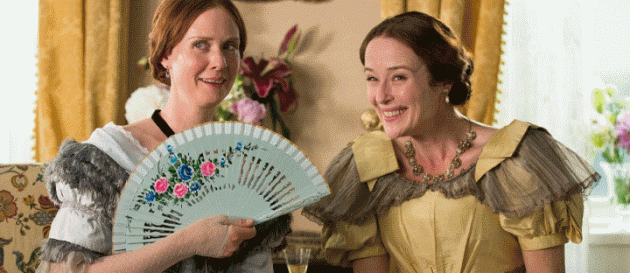
“Don’t resist your vices,” says Emily’s friend Miss Buffam, telling Emily to be outwardly docile but inwardly rebellious (often artists have been advised to be bourgeois in life but radical at work). Unfortunately, the Reverend Wadsworth, one of the rare persons who knew and appreciated her work while she lived, sails for San Francisco to lead a congregation there; and Emily and Vinnie argue about Emily’s attachment to him. Was Emily attached as well to Samuel Bowles, the married editor of the Springfield Republican? Her loneliness may inspire more poetry. (“Before 1858 there are only five known poems; in 1858, she wrote the first substantial group of poems, 43 in all, to enter her known oeuvre,” states Sharon Leiter in Critical Companion to Emily Dickinson: A Literary Reference to Her Life and Work, from Facts on File, 2007; page 13. Dickinson wrote 227 poems in 1862.) Life goes on—until it does not. Miss Buffam marries. Emily’s father dies.
A publisher, Mr. Bowles, visits Emily and she, who often wore white rather than black after her father’s death, admits to feeling fear due to her isolation and complains of Bowles’s editing her punctuation, which changes the meaning of her lines. A beautiful young man comes to call, but Emily, thinking she lacks beauty, refuses to go downstairs to meet him, instead speaking to him from afar. Yet Emily yearns: for what or whom does she yearn? A spiritual presence? An earthly presence? Emily is rude to her beautiful visitor to her sister’s mortification. Vinnie observes that a rebellious spirit invites retribution. (Yet, Vinnie was not endless sweetness; and Vinnie is known to have fought, later, with the Todd family about land, even lying under oath to get it.) Emily becomes ill, has a fit, and is diagnosed with a bad liver, Bright’s disease (named for its description by physician Richard Bright), for which diuretics are prescribed for relief although there was no cure. (Others have noted Dickinson’s various ailments, from eye trouble to vexed nerves.)
Emily’s mother dies. (Emily had said that when her mother became a child again, by becoming ill, the two became closer.) Austin, to Emily’s dismay and anger, becomes infatuated with an accomplished married woman, the musician Mabel Loomis Todd, Mrs. Todd (the wife of David Peck Todd, a professor of astronomy, who has some kind of physical malady); although it would be Mrs. Todd who with Thomas Higginson would help to publish Emily’s work. Emily and Austin, after evidence of his affair, argue about morality and hypocrisy. Austin reads aloud a published opinion by Mr. Bowles on the literature of misery as written by women, implying a critique of Emily’s work. Emily is hurt but sees her own bitterness and recognizes her sense that the world is ugly. (Emily Dickinson, who thought suffering could be strengthened, like sinews, by time, did have an affectionate relationship, late in life, with Otis Phillips Lord, an old and ailing judge who offered marriage, which she did not accept.) Did Emily Dickenson think the world ugly? One suspects that she, like many great artists, may have been frustrated by the world but finally accepted its complex nature as a fact. Interpreters tend to see in their subjects for not only what is to be found there—genuine discoveries of fact and revelations of feeling—but also as projections of what the interpreters are looking for, aspects that fulfill their own expectations of a complete person and life, or a flawed life, ending in an approving or disapproving judgment of the world. The photoplay A Quiet Passion presents a portrait of a solitary woman and a great artist, gifted and haunted, obscure and immortal.
Emily Dickinson’s work is intimate and philosophical, the writing of a lone woman that became one of the foundations of her country’s modern literature. “A WORD is dead / When it is said, / Some say. / I say it just / begins to live / That day,” wrote Emily Dickinson, whose poetry survived the end of her body’s breathing (Poems; page 154). The director of A Quiet Passion, Terence Davies, has a particular even peculiar sensibility, in terms of focus, content, and tone, in terms of rhythm and pacing. His interpretations are passionate and prim. The movement of characters is eccentric, formal—the speech and gestures of people who are comfortable, educated, but isolated, not having been roughened by rubbing against many others. The recitations can be delightful or shocking. Emily Dickinson, a woman of contradictions, a poet of profound power, has found an appropriate interpreter of her life and work in cinema. Anthony Scott, whose work can be cited for its intelligence and prestige or as a symptom of the questionable prevailing cultural currents, when reviewing the motion picture in the New York Times, found A Quiet Passion “a visually gorgeous film—full of sunlight and flowers, symmetry and ornament—that also feels refreshingly plain. The smooth, almost lyrical movement of the camera conveys lightness and gravity, much in the way that some of Dickinson’s poems do. Like her voice, it seems to have been set loose in time, to rush forward or to linger as the meaning and the meter require, to turn time itself into a series of riddles. The movie lasts for two hours, or 37 years, or the difference between now and forever, or the span of an idea” (April 13, 2017). However, Emily Orlando wrote a commentary for the July 13, 2017 Amherst Bulletin in which she declared the film lacking in the affirmation, hope, and passion Orlando saw in Dickinson and Dickinson’s poetry, and too death-obsessed. Often people are disappointed in cinema portraits of great artists: a complex person, life, and work are summarized in a fragmentary, short audio-visual statement; and while the great artist was committed to transformation and transcendence, much of the cinema world and its audience want to know what the artist wanted to transcend: the conformities of dull days, the love affairs and drinking tastes, the dirty laundry and gossip of neighbors, the ordinary faults and questionable habits. Emily Dickinson was scrupulous, and there was not in her life the usual drama mined in biographies; thus family conflict and a coming death have a special resonance, practical and symbolic. Of course, everyone can have his or her own Emily Dickinson, beginning with the reading of Dickinson’s work.
Submitted March 2018


